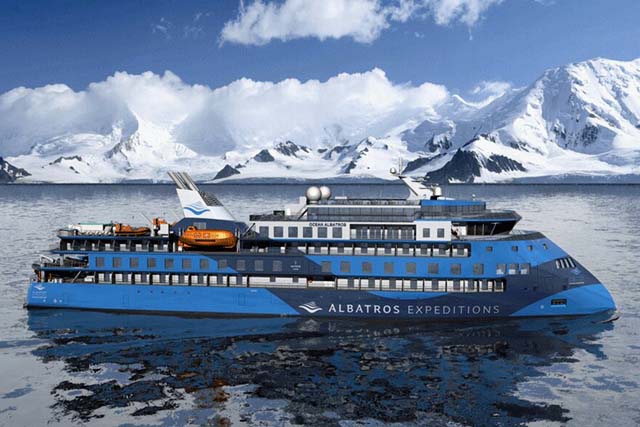Sea Trials of ‘Ocean Albatros’, Sunstone Ships’ latest Ulstein-designed cruise vessel, encountered what were described as “terrible weather conditions, which included more than 20m/s storm and heavy fog”, but the vessel performed well and was completed in time for the Chinese New Year.
According to shipbuilder China Merchants Industry Haimen (CMHI), after eight days of continuous struggle, the ship successfully completed the trials, during which all equipment was found to be in good running condition, operating performance was superior, with all indicators are in line with the design standard.
Ocean Albatros is one of the vessels in the SunStone Ships’ Infinity Class, designed by Ulstein Design & Solutions. Although all six vessels are based on the CX103 design, they are all customised. Some have a row of triangular-shaped windows in the bow part, and they have accommodation for various numbers of passengers, and different public space designs and expedition logistics. All feature the X-Bow, which as well as minimising slamming and shaking, enables views for passengers directly to the sea level, both from the lower and higher positions on deck.
By parting the waves, the X-Bow ensures a smoother ride in rough crossings. Consequentially, travel time can be reduced, and fuel consumption cut, making this vessel a better choice for the environment.
The charterer, Albatros Expeditions, which also operates the sister vessel, Ocean Victory, has announced record-low emissions per passenger for that vessel. The ship uses 60% less energy, and its Tier III compliant engines limit the amount of nitrous oxides. It only burns marine gas oil, which emits less CO2 per ton burned compared to heavier bunker fuel.
All the vessels in the Infinity class, including the Ocean Albatros, have engines with SCR catalysts to reduce emissions. They run on low-sulphur MGO, and have heat recovery systems and LED lights. The wastewater treatment and management system cleans the wastewater before discharging it. The ships have zero-speed stabilisers and dynamic positioning and are built to Polar Code B, with Polar Class 6 (Ice Class 1A on machinery) notation.



